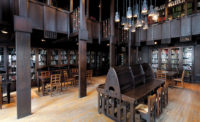Even as flames poured from the roof of the Glasgow School of Art (GSA) on the night of June 15 and before the damage could be fully assessed, passionate debate on the building’s future began. Online and in the morning’s newspapers, architects began to advocate for different approaches to Charles Rennie Mackintosh’s masterwork, built 1897–1909, which was nearing the end of a $45 million restoration following a smaller fire in 2014.
Prominent Scottish architect Alan Dunlop suggested that the destruction appeared so comprehensive that any reconstruction would produce a “sad replica” and that an ambitious new building would make a better legacy. GSA professor Ray McKenzie offered another radical proposal: leave the ruin to stand “as a silent witness to the value—and the precariousness—of history itself.”
Over the following days, as it became clear that large areas of stonework had survived, GSA director Tom Inns told the BBC that the building “will be saved in some form,” and discussion among architects turned to the question of whether to build an exact replica or reconstruct with contemporary additions that acknowledge its troubled history.
Conservation architect Julian Harrap, who collaborated with David Chipperfield on the repair of Berlin’s Neues Museum, argued that an exact copy would be a “disgrace” to the profession, while a wholly new building would be “equally unacceptable.” Chipperfield also came out in favor of reconstruction but added that the approach “should be based on intellectual and technical criteria and opinion.”
An argument for the faithful reconstruction of the school “exactly as it was just before the 2014 fire” came from architect John McAslan, who restored Haiti’s Iron Market after the 2010 earthquake, only to see it burn down again this year. This also seems to be the view of the GSA. On July 10, Inns told the Guardian that “it is critically important that the building comes back as the Mackintosh building.” Although the cause of the blaze is not yet known, he also expressed confidence that insurers will foot the bill.
He spoke as contractors prepared to dismantle some unstable walls. Later assessments will show what materials might be reused, but new 3-D scans are being added to an already formidable quantity of documentation. The recent restoration project bolstered that knowledge and showed the quality of work that can be done. The school and its supporters will now dig even deeper to preserve an icon of world architecture.



Post a comment to this article
Report Abusive Comment